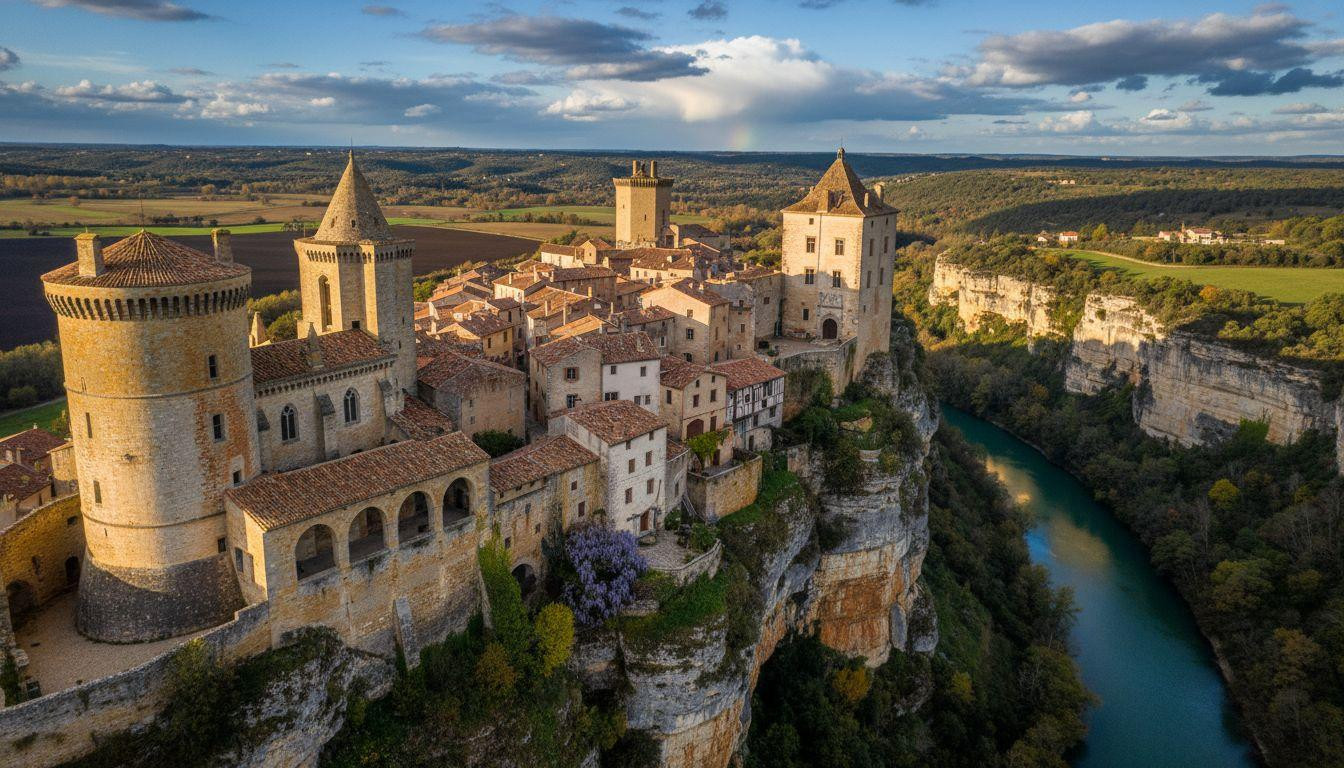Twin medieval castles crown a knife-edge promontory 295 feet above the Aveyron River, where 632 residents live between limestone walls that glow amber at dawn. Bruniquel preserves nearly 900 years of continuous village life on this rocky spur in southwestern France, where a Renaissance family feud created the only double-fortress settlement in the region. This morning, golden light touches the twin castle facades while river mist rises from the gorge below.
The cliff-edge setting that defies gravity
The village occupies a limestone ridge barely 240 feet wide at its narrowest point. Twin castles balance on opposite ends of this precarious perch, connected by cobbled streets that follow the ridge’s natural curve. The Aveyron River carves through Jurassic limestone 295 feet below, creating walls of honey-colored stone that catch morning light like amber glass.
From Toulouse, the one-hour drive follows progressively quieter countryside along the D964. The final approach reveals Bruniquel’s dramatic positioning: medieval houses balance on this knife-edge ridge where the river bends through southwestern France. November mornings bring atmospheric mist that clings to the gorge walls before sunrise burns it away.
The twin castle revelation: when siblings feuded
Two centuries after its 12th-century construction, the original castle was divided between rival branches of the Comminges family. This architectural divorce created Château Vieux (Old Castle) and Château Jeune (Young Castle), connected by adjoining courtyards but representing entirely different eras of medieval life.
Queen Brunehaut’s tower and royal origins
The 92-foot Queen Brunehaut Tower anchors Château Vieux with 12th-century stonework. According to historical records, Merovingian Queen Brunehaut established the first fortress here in the 6th century on Roman foundations. Today’s visitors climb 127 steps to reach the tower’s summit, the highest viewpoint in the village.
The Renaissance gallery over the abyss
Château Vieux’s Renaissance gallery stretches 66 feet along the cliff edge, its six limestone arcades framing a 295-foot drop to the river. Built in the late 15th century, this architectural marvel overhangs the valley with original 16th-century carvings. The gallery offers 270-degree panoramic views across the Aveyron gorge, where swallows circle the tower walls until late October.
Walking medieval streets where history lives
Cobbled streets wind between limestone facades dating to the 15th, 16th, and 17th centuries. Local limestone setts follow an irregular herringbone pattern with central drainage channels. Street widths range from 8-11 feet, designed for medieval defense but creating intimate exploration today.
The sensory experience of ancient stone
Footsteps echo against cobblestones in the quiet morning hours. Church bells mark 8:00 AM, noon, and 6:00 PM, their chimes bouncing off twin castle walls. Climbing roses and lilacs soften the fortress aesthetic, introducing botanical texture amid honey-colored stone. The mineral scent of limestone intensifies after rain, mixing with occasional wood smoke from village chimneys.
Connection to humanity’s oldest construction
Beneath the medieval village lies Bruniquel Cave, where Neanderthals built circular stone structures 176,500 years ago. These formations represent the oldest known human construction inside any cave worldwide, predating Chauvet Cave by over 100,000 years. The cave remains closed for scientific research, though prehistoric significance echoes in other French heritage sites.
Authentic village life versus tourist theater
Bruniquel receives 320 daily visitors compared to Carcassonne’s 5,200, creating a 16-to-1 crowd difference. Castle admission costs $8 versus Carcassonne’s $10, while cassoulet meals average $24 compared to Carcassonne’s $31. The village maintains just 3 souvenir shops among 632 residents, a ratio of 1 shop per 210 people.
Two active artisan workshops operate year-round: stone carving (since 1987) and ceramics (since 2003). Thursday markets feature 22 vendors selling local cheeses, charcuterie, and seasonal produce. Authentic artisan traditions continue without tourism performance, maintained by families who’ve lived here for generations.
Your questions about Bruniquel answered
When should I visit for the best experience?
Late April through May offers ideal conditions with 50-63°F temperatures and blooming roses. November provides atmospheric morning mist and just 185 daily visitors (versus summer’s 1,200). The “golden hour” occurs 45 minutes after sunrise and before sunset, when limestone walls glow amber against the river gorge.
How does this compare to famous French villages?
Bruniquel costs 40-60% less than Provence villages for accommodations ($105-180/night versus $110-275). The village preserves authentic community life with 58% working residents, while tourist-focused destinations depend entirely on visitor revenue. Medieval preservation here maintains lived-in character rather than museum presentation.
What makes the twin castles architecturally unique?
No other French hilltop village features twin castles built by feuding family branches on a single promontory. The architectural timeline spans from 12th-century defensive design to Renaissance comfort-focused construction. Château Jeune deliberately prioritized aesthetic pleasure over military necessity, representing a rare philosophical shift in medieval architecture.
Standing on the Renaissance gallery at 4:30 PM, when November sun ignites limestone walls to amber and the Aveyron River reflects twin castle silhouettes, you experience architectural rivalry frozen in stone across nearly 900 years of continuous human habitation.
